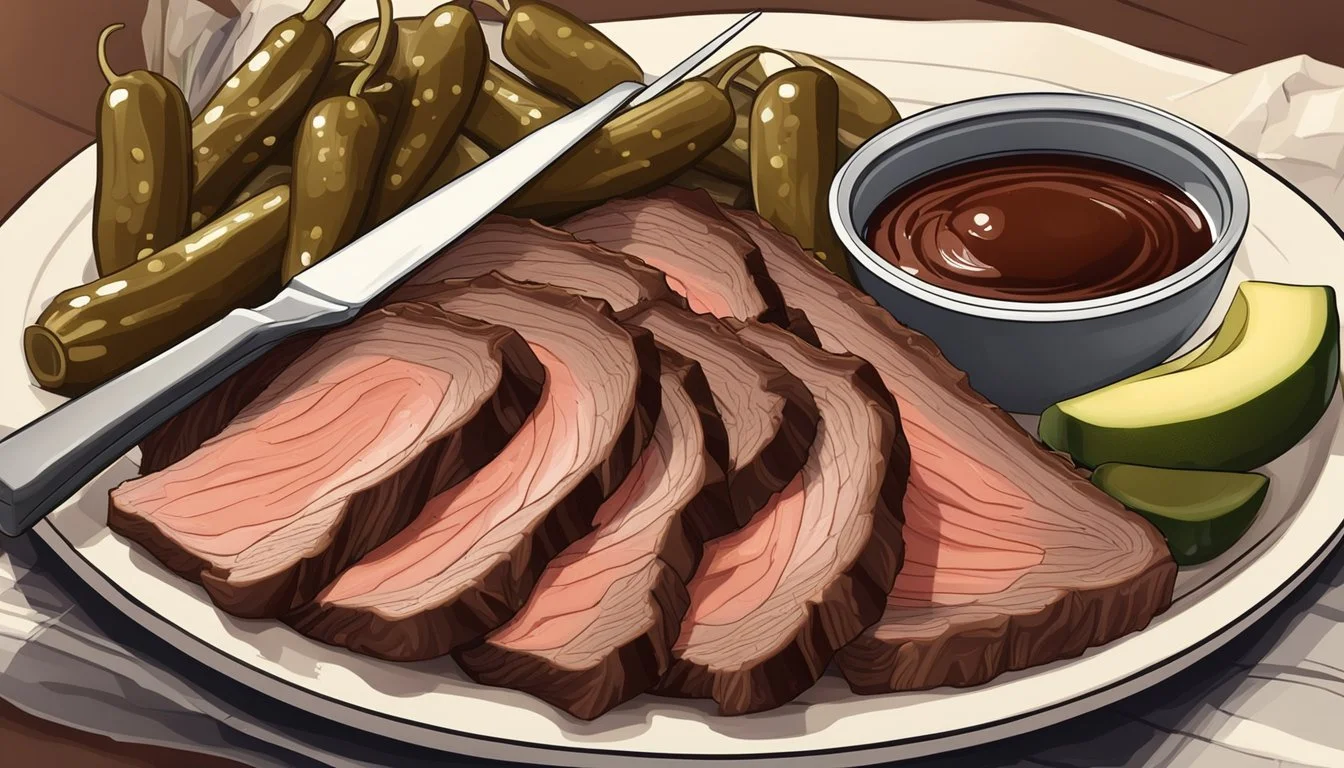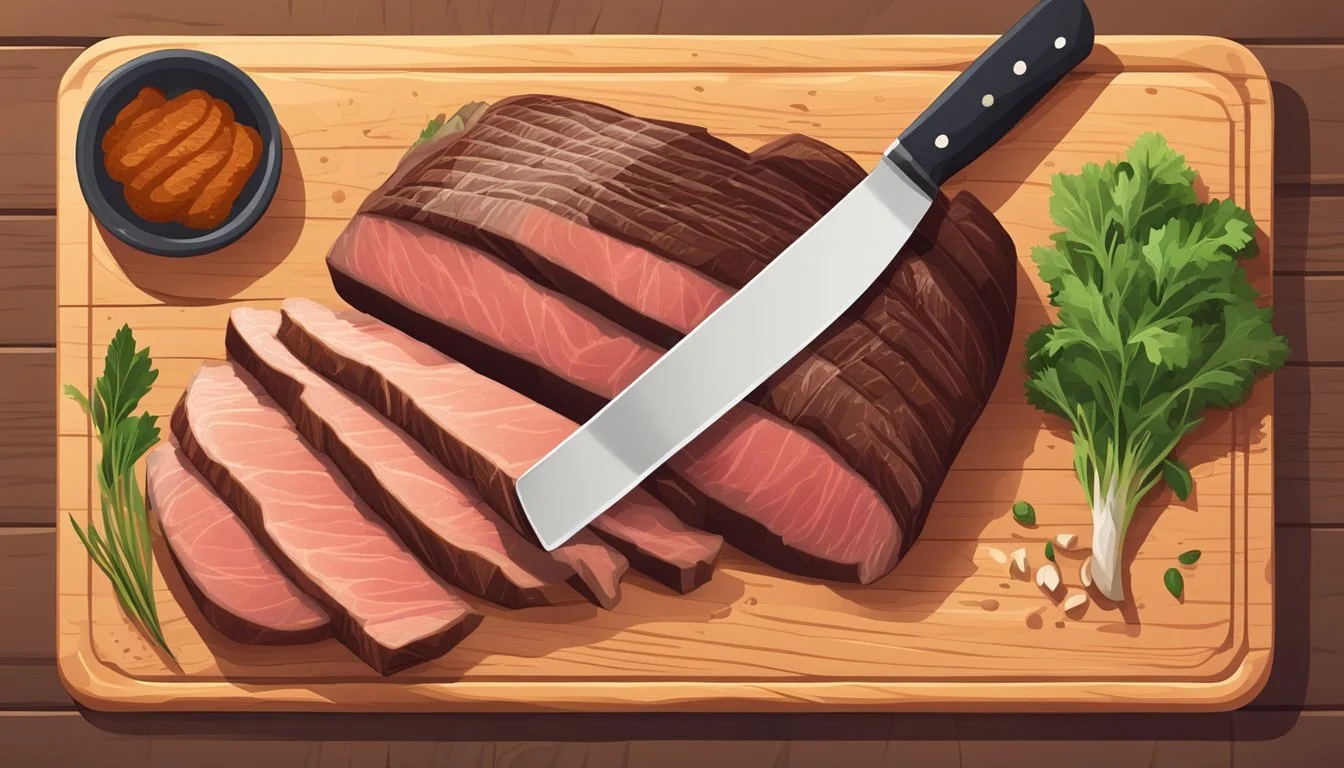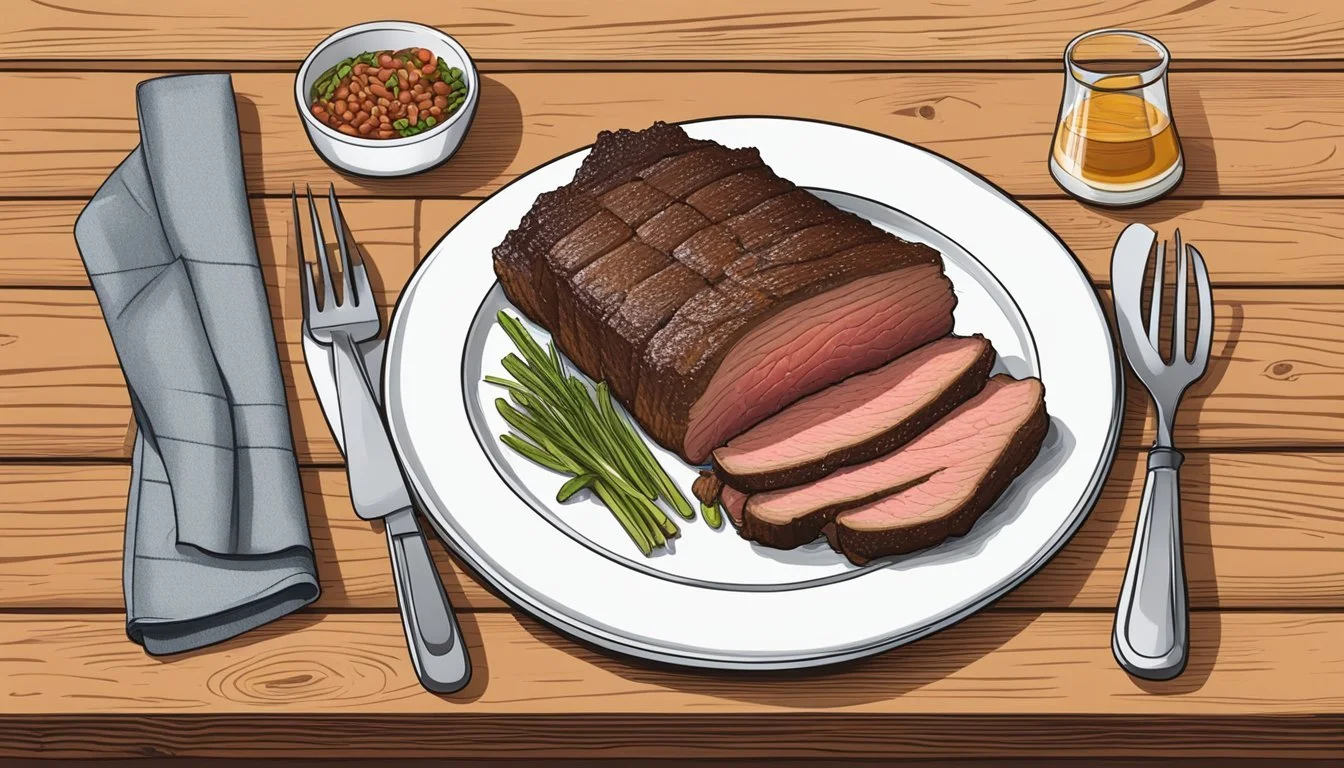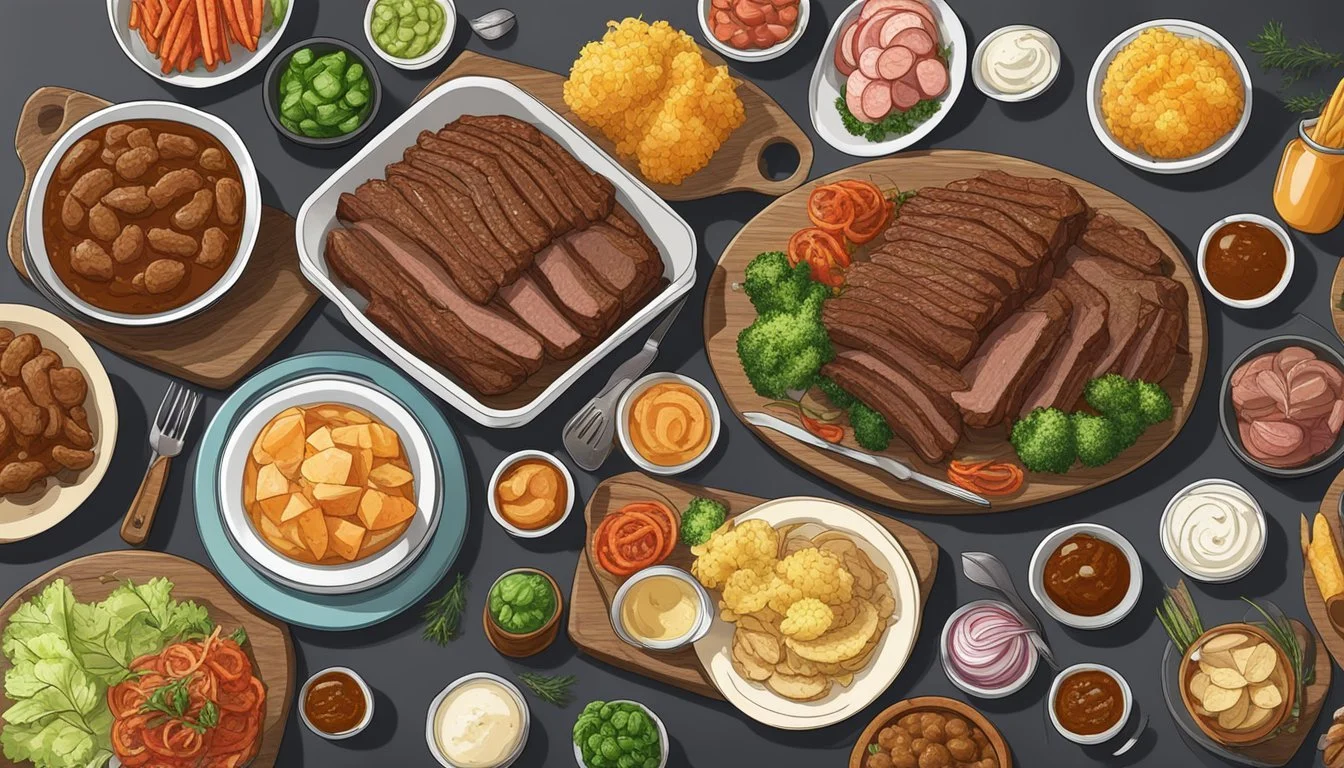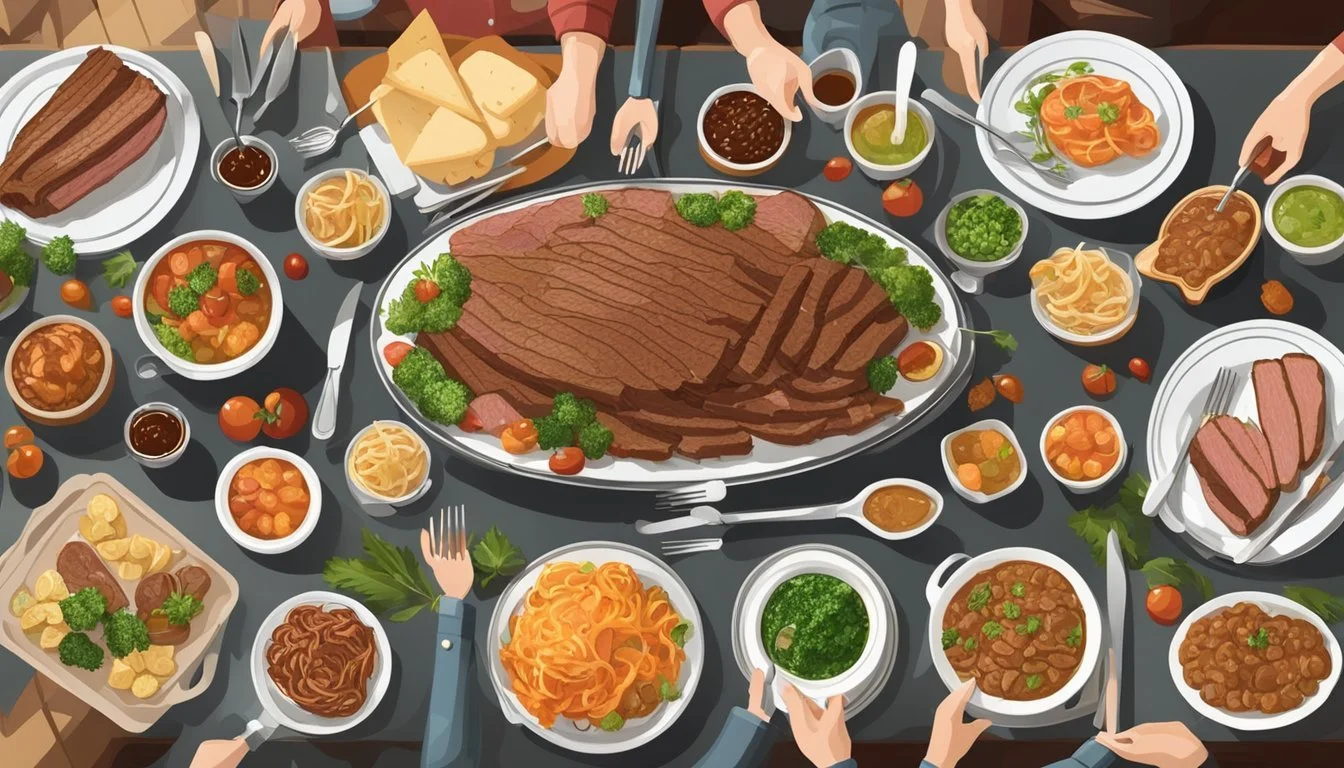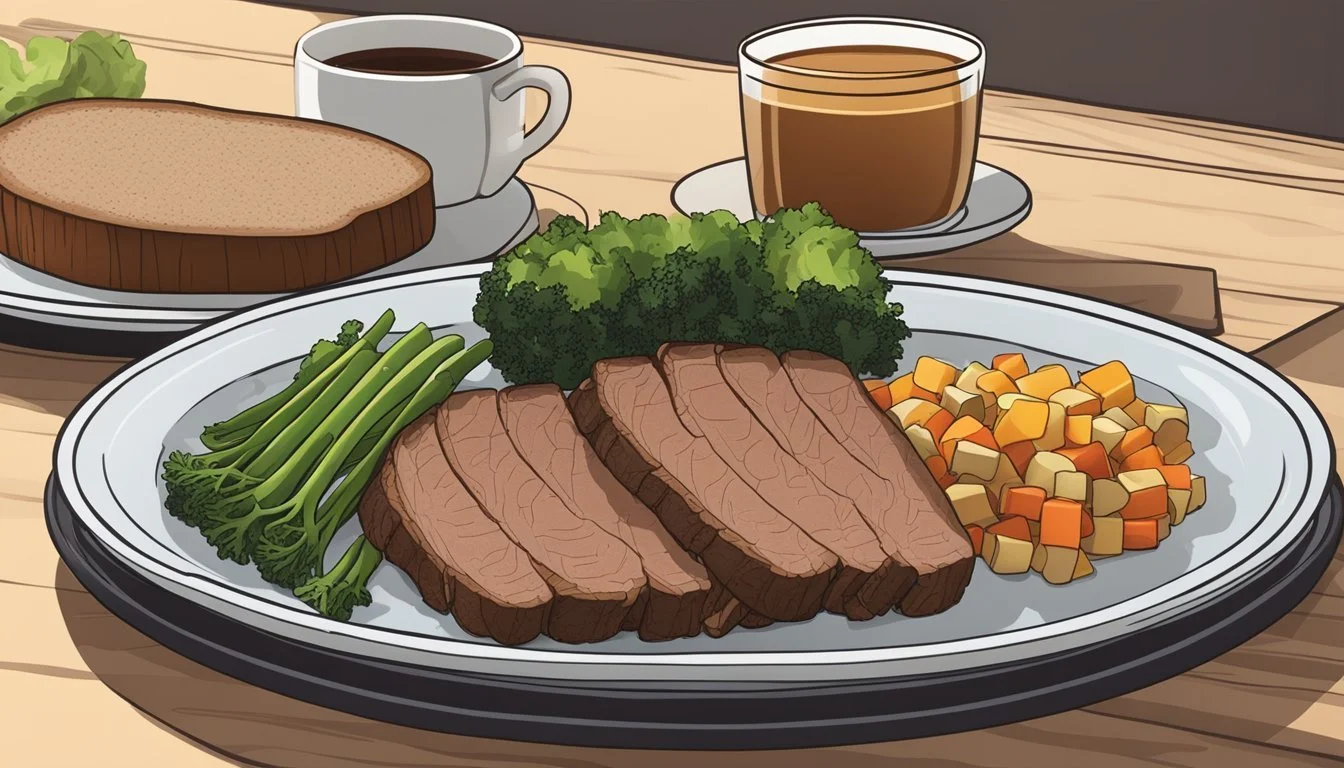How Do You Eat Beef Brisket?
Expert Tips for Enjoying this Classic Cut
Beef (What wine goes well with beef?) brisket is a cut of meat that comes from the breast section of the cow. It's known for its rich flavor, which is brought out through proper cooking methods. Due to the collagen fibers in the brisket, it requires a lengthy cooking time at low temperatures to transform into the tender, flavorful dish that many enjoy at barbecues and family dinners (What wine goes well with dinner?).
Eating beef brisket can be a delightful experience if prepared and served correctly. The meat is often slow-cooked, allowing it to become soft enough to be easily pulled apart or sliced without becoming tough or dry. Traditional methods of serving brisket include slicing it for sandwiches, incorporating it into larger meals with side dishes like roasted vegetables or green beans, or simply enjoying the meat on its own, often with a drizzle of barbecue sauce to complement its smoky flavor.
Beef brisket can also be a versatile ingredient across meal types. It's commonly featured in hearty dinners, but the leftovers can be repurposed into various meals, such as being shredded for breakfast tacos or layered into a sandwich for lunch. The key is to maintain the moisture and tenderness of the brisket regardless of how it's served, which can consist of softly re-heating and pairing it with complementary flavors and textures.
Understanding Beef Brisket
Beef brisket is renowned for its flavor and versatility, but it requires careful selection and preparation due to its naturally tough texture. This section demystifies brisket by discussing its anatomy, varieties, and selection criteria.
Anatomy of the Brisket
The brisket is a cut of meat from the breast or lower chest of the cow. This part of the cow supports much of its weight, involving a lot of connective tissue, making the muscle tougher. There are two main parts of the brisket:
Flat: This is the leaner portion, also known as the 'first cut', which is relatively uniform in thickness and well-suited for slicing.
Point: Also referred to as the 'second cut', this part is fattier, featuring a thicker, more irregular shape, rich in marbling, and it yields tender meat when cooked properly.
Brisket Varieties
Brisket is processed in several different ways, resulting in distinct varieties used in various dishes:
Raw Brisket: Unprocessed, typically used for barbecue.
Corned Beef: Brisket that's been cured in a brine solution with spices.
Pastrami: Begins like corned beef but also smoked after curing.
Selecting Quality Brisket
One should look for a brisket with the following characteristics to ensure quality and flavor:
Subtle marbling with white specks of fat throughout the meat for tenderness.
A thick, white fat cap on one side, which should not be excessive.
A deep red color indicating that it is fresh and well-handled.
A quality brisket, when prepared correctly, transforms from a tough cut of meat into a tender, flavorful dish. Whether it is barbecued, braised, or used for making corned beef or pastrami, understanding the brisket's characteristics will help guide in selection and preparation.
Preparation Basics
Before diving into the specific techniques of preparing beef brisket, one must understand that the meat's quality largely depends on proper fat management, seasoning, and the use of marinades or sauces to complement the cut's rich flavors.
Trimming the Fat
To ensure an even cook and to avoid excessive greasiness, it is essential to trim the fat cap on the brisket to about ¼ inch thickness. This allows for enough fat to render and moisten the meat during cooking without overwhelming the meat's natural flavors.
Seasoning Approach
A proper seasoning blend is key to a flavorful brisket. Begin with a generous application of salt and black pepper. For added complexity, incorporate spices such as
garlic powder
onion powder
paprika
A well-balanced dry rub can consist of:
Spice Quantity Salt 2 tbsp Black Pepper 1 tbsp Garlic Powder 1 tbsp Onion Powder 1 tbsp Paprika 2 tsp
Mix these together and rub onto the meat ensuring all surfaces are covered.
Choosing Marinades and Sauces
While some may prefer the simplicity of a spice mix, a brisket can be elevated with the right marinade or BBQ sauce. A marinade often contains an acid like vinegar or lemon juice mixed with olive oil and aromatics to tenderize and flavor the meat. As for sauces, a classic BBQ sauce which typically includes ingredients like tomato paste, vinegar, spices, and sweetness, can be applied near the end of cooking to prevent burning. Remember to reserve some sauce to be served with the finished dish, allowing diners to adjust to taste.
Cooking Techniques
Before diving into the specifics, it's important for the reader to understand that beef brisket can be cooked using various methods, each imparting its own unique flavor and texture. The key to cooking brisket is maintaining a consistent low temperature, allowing the connective tissues to break down and produce a tender result.
Smoking the Brisket
Smoking involves cooking the brisket in a smoker at a consistent temperature range, typically between 225°F and 250°F. This method requires a smoker or a barbecue grill set up for indirect heat and the use of wood chunks or chips for flavor. The brisket is usually smoked fat-side down and then wrapped in foil or butcher paper once it reaches an internal temperature of around 150°F to 160°F to retain moisture. The smoking process can take anywhere from 4 to 6 hours for a brisket to reach an internal temperature of 185°F to 190°F, resulting in tender meat.
Oven Roasting
When oven roasting a brisket, preheat the oven typically to 275°F and use a roasting pan. First, the meat should be seared on the stove to caramelize the surface. Then, it's slow-cooked in the oven, sometimes covered with foil to keep it moist, until it becomes fork-tender. The roasting process can take several hours, with the brisket's temperature monitored closely to prevent overcooking.
Grilling
Grilling brisket is less traditional but can be done similarly to smoking, with indirect heat on a grill. Arrange coals around a drip pan filled with hot water and add wood chunks to the coals for smoke flavor. Place the brisket over the pan and grill it, covered, at medium-low heat. Although grilling is faster than smoking, it often requires attentive heat control and the brisket should be flipped occasionally to ensure even cooking.
Slow Cooking
Using a slow cooker is an excellent way to cook brisket at a consistently low temperature without constant supervision. The brisket is placed in the slow cooker with a braising liquid, such as beef stock or a mixture of seasonings, and cooked on low heat. This method typically takes 7 to 8 hours, during which the meat absorbs flavors from the liquid and becomes exceptionally tender.
Pressure Cooking
For those short on time, pressure cooking offers a much quicker method to cook brisket. In a pressure cooker, the brisket is combined with liquids and seasonings, and the cooker is sealed to create a high-pressure environment that cooks the meat quickly. Depending on the size of the brisket, it can be done in about an hour. This style captures the flavors and tenderness but without the distinctive smokiness that smoking or grilling would impart.
Cooking Times and Temperatures
Cooking beef brisket to perfection involves low and slow cooking at precise temperatures and understanding the importance of resting the meat. Monitoring and carefully managing the cooking time and internal temperature are crucial to achieving tender, flavorful brisket.
Calculating Cook Time
The general rule for cooking beef brisket is based on weight, with a typical recommendation of 1 hour per pound of meat when cooked at 275°F (135°C). Nonetheless, variations in brisket size and desired doneness necessitate flexible cooking times:
Oven or Smoker Temperature: 225°F to 250°F
Cook Time: 1 hour per pound at 275°F
Final Internal Temperature for Doneness: 195°F to 205°F
Using this guideline, chefs can estimate the initial cooking duration, yet it's essential to check the meat's temperature as it nears completion, as individual brisket cuts may require more or less time.
Thermometer Usage
A reliable meat thermometer is indispensable for ensuring brisket is cooked safely and to the right level of tenderness. Here are the key points for thermometer usage:
Inserted into the Thickest Part: The probe should be placed in the center of the brisket's thickest section, not touching fat or bone.
Ideal Internal Temperature: The brisket is optimally done when it reaches an internal temperature of 195°F to 205°F, depending on personal preference.
Rest Before Slicing: After cooking, the brisket should rest with the lid on for at least 30 minutes. This period allows the juices to redistribute, enhancing tenderness and flavor.
Always keep the lid closed to maintain a consistent temperature within the cooking environment and reduce the frequency of opening the lid to preserve heat.
The Resting Stage
After the beef brisket is removed from the smoker, it enters a crucial phase known as the resting stage. This step is essential for achieving optimum tenderness and flavor. The resting allows the juices within the brisket to redistribute throughout the meat, ensuring that each bite is moist and delicious. Without a proper rest, the brisket may be tough or dry.
Duration of Rest:
Brisket should rest for at least 30 minutes before being sliced.
A longer rest of up to 1 hour is often recommended for better results.
For those who plan to hold the brisket longer, it can be kept in an insulated cooler for up to 4 hours without losing heat.
Methods for Resting:
Resting can be done in several ways:
In a Cooler:
Allows for a controlled environment where the brisket remains warm.
Prep the cooler with hot water prior to placing the brisket to maintain temperature.
In a Pan:
The brisket can be transferred to a dish that can catch any escaping juices.
Cover loosely with foil, ensuring to vent one corner.
Handling the Brisket:
It's advisable to keep the brisket wrapped in thin aluminum foil or butcher paper during the rest.
Wrapping helps in retaining heat and moisture.
If using a towel to wrap, ensure it is clean and can cover the brisket entirely.
The resting stage is not to be underestimated. It's the period that allows the brisket to transition from cooked to irresistibly tender. Respecting this stage is the pitmaster's secret to a perfectly cooked beef brisket.
Slicing and Serving
Expertly slicing and presenting beef brisket transforms it into a culinary delight, whether it's for a casual lunch or an elaborate dinner. The tenderness of brisket slices paired with complementing sides and sauces elevates the dining experience.
The Art of Slicing
When it comes to beef brisket, the key to perfect slices is in the technique and knife. Always slice against the grain to ensure each piece is tender and maintains its flavor. For the flat, aim for pencil-thick slices, about 1/4-inch each. When you reach the point, a fattier section, consider cutting it in half lengthwise to manage the different grain direction and to render slices with a blend of lean and marbled textures.
Tools and Techniques:
Use a long, sharp knife for even cuts.
Identify the grain direction before slicing.
Begin slicing the flat, then progress to the point.
Keep slices uniform for consistent servings.
Presentation and Garnishes
A visually appealing plate is pivotal. Arrange brisket slices neatly on a warm platter; drizzle with barbecue sauce if desired. When serving, balance the robustness of beef brisket with sides like creamy potato salad, tangy coleslaw, and brightly colored grilled veggies such as bell peppers, onions, and potatoes. For an added crunch, supply a side of pickles. Lunchtime often calls for brisket to be served in brioche buns or atop nachos, while dinner might feature more substantial sides like corn on the cob.
Side Suggestions:
Sides Sauce Garnishes Potato Salad Barbecue Sauce Pickles Coleslaw Sour Cream Chopped Onions Grilled Veggies Horseradish Sauce Fresh Herbs Corn on the Cob - - Nachos - Jalapeños
Complement the beef's richness with sauces like sour cream, horseradish, or a homemade barbecue sauce to heighten the flavor. Whether enjoying a slice of brisket or a fully dressed brisket sandwich, the combination of well-carved meat, satisfying sides, and zesty garnishes creates a memorable meal.
Brisket Recipe Recommendations
When it comes to preparing beef brisket, the versatility of this cut allows for numerous cooking methods and recipe options. Pulled Brisket Sandwiches are an excellent choice, involving the simple steps of heating a blend of butter, brown sugar, ketchup, and pepper sauce, then shredding the brisket and serving it on Kaiser rolls with the sauce drizzled on top.
Oven Roasting is ideal for those attempting brisket for the first time. The key is to first sear the meat to caramelize it, then let it cook slowly in the oven at a low temperature, approximately 275°F, ensuring the meat is tender and flavorful.
For barbecue enthusiasts, the Smoked Brisket option is irresistible. This involves setting up a grill with medium-hot coals around a drip pan with hot water, adding wood chunks for smoke, and then cooking the brisket over the pan until it reaches an internal temperature of 185°F to 190°F.
For a Juicy Beef Brisket roasted in the oven, adding a mixture of beef broth and water to the pan and covering it tightly with foil helps to maintain moisture. The brisket is cooked at a high temperature for the initial hour and then at a reduced temperature until it becomes fork-tender.
Lastly, a Slow-Cooked Beef Brisket can be made by marinating the meat with a blend of mustards, honey, and spices. Cooking it at a low temperature in the oven tenderizes the brisket while infusing it with the flavors of the marinade.
ItalicColumns below summarize the key points of each method:
Method Temperature Cooking Time Note Pulled Brisket Sandwiches Stove Top Varies Use Kaiser rolls, drizzle with sauce Oven Roasting 275°F Slow Cooking Sear before slow-cooking Smoked Brisket Medium-Low Heat 4-5 hours Internal temp 185°F to 190°F Juicy Beef Brisket 350°F, then 300°F 4-5 hours Add beef broth and water Slow-Cooked Beef Brisket Low oven temp Varies Use a flavorful marinade
Side Dishes
When serving beef brisket, the chosen side dishes are crucial in creating a balanced meal. They provide complementary textures and can enhance the brisket's rich flavor.
Vegetable Pairings
A variety of vegetables can accompany beef brisket. Choices such as steamed asparagus or a tangy Brazilian tomato slaw with tomatoes, onions, red bell peppers, and cucumber offer a fresh counterbalance to the meat's heaviness. For added flavor, asparagus may be topped with browned butter, or tossed with lemon and black pepper. Another popular option is corn on the cob, which provides a sweet and juicy contrast to the savory brisket.
Starch Selections
Starchy sides provide a hearty complement to brisket. Traditional mashed potatoes, creamy and smooth, can be seasoned with garlic or herbs for extra zest. A potato salad with mayo, mustard, dill pickle relish, and hard-boiled eggs offers a cold, creamy texture with a tangy taste. Additionally, serving warm, buttery rolls on the side ensures guests have something to soak up the brisket's flavorful juices.
Leftover Ideas
When working with leftover beef brisket, the key is to properly store and reheat the meat while letting creativity shine through in transforming it into equally delicious dishes.
Storing Leftovers
Leftover brisket should be stored in an airtight container to maintain its freshness. It is ideal to place the cooked brisket in the fridge within two hours of cooking. They can typically last up to four days when refrigerated properly.
Reheating Techniques
Proper reheating ensures the brisket remains tender and flavorful. One can reheat brisket in a preheated oven at 325°F. Wrap the brisket in foil and place it in an oven-safe dish with a few tablespoons of broth to keep it moist. Another method is to gently reheat it in a covered skillet on a low to medium heat.
Creative Recipe Transformations
Transforming leftover brisket into new meals can be a delightful experience. Here are some ideas:
Brisket Sandwich: Use brioche buns and leftover brisket slices to create a hearty sandwich. Add pickles, onions, and your favorite sauce for a simple yet satisfying meal.
Nachos: Crisp tortilla chips topped with brisket, cheese, and jalapenos, then broiled until melted, make for irresistible nachos.
Brisket Recipes: Utilize the brisket in a:
Beef Ragú: Simmer the brisket with tomatoes and herbs until tender.
Stir-fries: Quickly fry vegetables and add brisket at the end to warm through.
With these guidelines, leftovers transform from mere afterthoughts to anticipated meals with a flair of originality.
Sauces and Toppings
When it comes to beef brisket, the sauce can make or break the dish. Selecting the right sauce is crucial for complementing the smoky and rich flavors of the meat. Toppings, whether crisp, tangy, or spicy, add texture and enhance the overall flavor profile.
Homemade Sauces
For those who take pleasure in crafting their own sauces, a BBQ sauce made from ketchup, brown sugar, vinegar, and a selection of spices such as garlic and onion powders can be tailored to one’s taste. A tangy Worcestershire sauce with a complex flavor profile can also be prepared with ingredients like vinegar, molasses, and anchovies, (What wine goes well with anchovies?) perfectly complementing the brisket’s savory notes.
Must-have BBQ Sauce Ingredients:
Ketchup
Brown sugar
Apple cider vinegar
Paprika
Garlic & onion powder
Worcestershire Sauce Mix:
Vinegar
Molasses
Sugar
Onion
Garlic
Anchovies
Store-Bought Options
For convenience, store-bought sauces are readily available and can offer a wide range of flavors. Barbecue sauce varieties from sweet and smoky to spicy and tangy are suitable for brisket. Those who prefer a less traditional approach might consider sauces such as a creamy horseradish or a bourbon-infused BBQ sauce to add a unique twist.
Popular Store-Bought Sauces:
Spicy BBQ
Bourbon BBQ
Horseradish Sauce
Fresh Toppings
Fresh toppings bring a burst of flavor and texture to a brisket meal. A dollop of sour cream can provide a refreshing contrast to the dish’s richness, while tangy pickles cut through the fattiness. Freshly sliced raw jalapenos offer heat, whereas sautéed bell peppers lend a sweet and smoky note, elevating the overall dining experience.
Fresh Toppings for Brisket:
Sour Cream: Creaminess to balance richness
Pickles: Tanginess for fatty cuts
Jalapenos: Spice to kick up the heat
Bell Peppers: Sweet smokiness for depth
Special Occasions
Beef brisket can transform any special occasion into a memorable feast given its versatility and rich flavors. Whether it's a smoked centerpiece for Easter, an outdoor barbecue rack, or a comforting pot roast at a family dinner, the brisket's adaptability shines through in various cooking methods appropriate for holiday menus, outdoor gatherings, and family dinners.
Holiday Menus
During holiday celebrations, beef brisket often takes center stage. Easter, for instance, may see a brisket masterfully smoked and adorned with a honey glaze, offering a tender and savory alternative to traditional lamb. Holiday menus can benefit from the brisket's ability to feed a crowd, especially when considering the important factor of the meat's reduction during cooking.
Easter Dinner:
Smoked Brisket: 1/4lb to 1/2lb per person
Glazes: Honey or fruit-based for a sweet twist
Outdoor Gatherings
For outdoor gatherings, such as summer barbecues, beef brisket proves to be a quintessential favorite. Barbecue enthusiasts often celebrate the brisket's potential for flavor and tenderness when prepared over a slow-cooked rack. Marinated and seasoned beforehand, brisket becomes the highlight of any cookout.
Preparation: Marinate and season for taste
Cooking: Long, slow cook on a grill rack
Temperature Check:
Doneness: Internal temperature of 185°F to 190°F
Family Dinners
In the context of family dinners, a beef brisket can be enjoyed as a succulent pot roast, making it a warming and comforting choice. The slow cooking process allows the flavors to deepen and the meat to become fork-tender. A family-sized portion often requires calculating the weight of the brisket pre-cooking to account for the reduction during the cooking, ensuring everyone gets their fair share.
Dinner Feature:
Pot Roast: Cooked with vegetables like carrots and potatoes
Servings: Calculate based on pre-cooked weight for accurate portions
Health and Nutritional Information
Beef brisket is a tender cut of meat that offers a range of nutritional benefits when prepared correctly and enjoyed as part of a balanced diet. It contains protein, vitamins, and minerals, but special attention should be given to its fat content and how it fits into one's diet.
Dietary Considerations
Brisket is rich in protein and contains varying levels of fat depending on how it is trimmed and cooked. The flat half of the brisket, which is separable lean only and trimmed to 1/8" fat, embodies a healthier choice within the beef spectrum. For example, a serving size of 1 ounce (28.35 grams) of cooked, braised beef brisket typically has the following nutritional profile:
Calories: 55.6 kcal
Total Fat: 1.7 g (27.6% of calories from fat)
Protein: 7.88 g
It's important to note that cooking methods can greatly affect the fat content; slow cooking methods like braising generally retain more of the meat's natural nutrients. Additionally, brisket contains oleic acid – a heart-healthy monounsaturated fat – that can help to increase levels of HDL cholesterol.
Portion Control
The key to incorporating brisket into a healthy diet is portion control. Since brisket is often served in large portions, it is essential to be mindful of the serving size:
A typical portion of brisket should not exceed 3 ounces (about 85 grams) for a balanced meal.
A 3-ounce serving of cooked corned beef brisket provides approximately 213 kcal, with 15.5 g of protein and 16.2 g of fat.
Monitoring sodium intake is also crucial, as brisket can be high in salt, especially in its corned beef form, which has about 827 mg of sodium per 3-ounce serving.
By taking into account these dietary considerations and practicing portion control, individuals can enjoy beef brisket as part of their diet while maintaining nutritional balance.
Buying Guide and Tips
When purchasing beef brisket, the consumer faces choices regarding where to buy and what specifically to look for in terms of quality and price. The primary considerations should be the source of the meat and the cost factors influenced by weight and quality.
Butcher vs. Supermarket
Butcher: Shopping from a local butcher often means access to higher-quality brisket with better marbling and a more even fat cap. The customer can usually request specific cuts and receive more personalized advice on selection and preparation.
Pros:
Superior meat quality.
Expert guidance available.
Customization of cuts.
Cons:
Potentially higher prices.
Limited availability.
Supermarket: A supermarket may offer convenience and possibly lower prices. However, the selection may be more limited, and the staff may not provide the same level of expertise as a butcher.
Pros:
Convenience.
Variety of price points.
Pre-packaged options.
Cons:
Variable meat quality.
Less knowledgeable staff.
Cost Factors
Cut: The cut of brisket can influence the price, with the flat cut often being leaner and more expensive, and the point cut being fattier and often more flavorful and cheaper. A whole "packer" brisket includes both cuts but requires skilled trimming.
Fat: Brisket should have a good layer of white, hard fat on the top which can be trimmed to preference. While more fat can mean more flavor and moisture, too much can be wasteful and impact the price-to-meat ratio unfavorably.
Weight: Prices can vary greatly based on weight. A general guide is to purchase 1/2 pound of raw brisket per person, as there is a significant amount of fat to be trimmed and the meat will shrink during cooking.
Pricing Considerations:
Cut: Flat cut is pricier than point cut.
Fat Quality: Look for firm, white fat.
Weight: Account for fat trim and cooking shrinkage.
Related Cuts and Dishes
Beef brisket is known for its rich flavor and tender texture when cooked properly. This section explores how brisket compares to similar cuts of meat and highlights dishes derived from brisket that showcase its versatility.
Comparing Brisket To Other Cuts
Chuck: A different cut from the cow, the chuck comes from the shoulder area and while it shares the characteristic of being tougher, requiring slow cooking, it typically has a higher fat content than brisket. This lends itself well to dishes like pot roast, where the meat is braised to achieve tenderness.
Pastrami and Corned Beef: Both are derived from brisket. To create pastrami, the meat is brined, partially dried, seasoned with herbs and spices, then smoked and steamed. Corned beef, on the other hand, is simply brisket that's been brined and then boiled or steamed. They offer different taste profiles due to their unique preparation methods.
Derived Dishes
Derived dishes from brisket highlight how cooking techniques can transform this cut:
Pastrami: Comes from the brisket and after the curing and cooking process, ends up as a deli favorite, typically served on rye with mustard.
Corned Beef: Another variation of brisket that's often the star in dishes like corned beef hash or served with cabbage for a traditional Irish-American meal.
Pot Roast: While not always made from brisket, this dish involves slow cooking the meat with vegetables in a covered pot, leading to a similar tenderness and flavor profile.
By comparing brisket to other beef cuts like chuck, or exploring its transformation into specialties like pastrami and corned beef, it's clear that brisket's culinary versatility allows it to be enjoyed in a multitude of ways.


